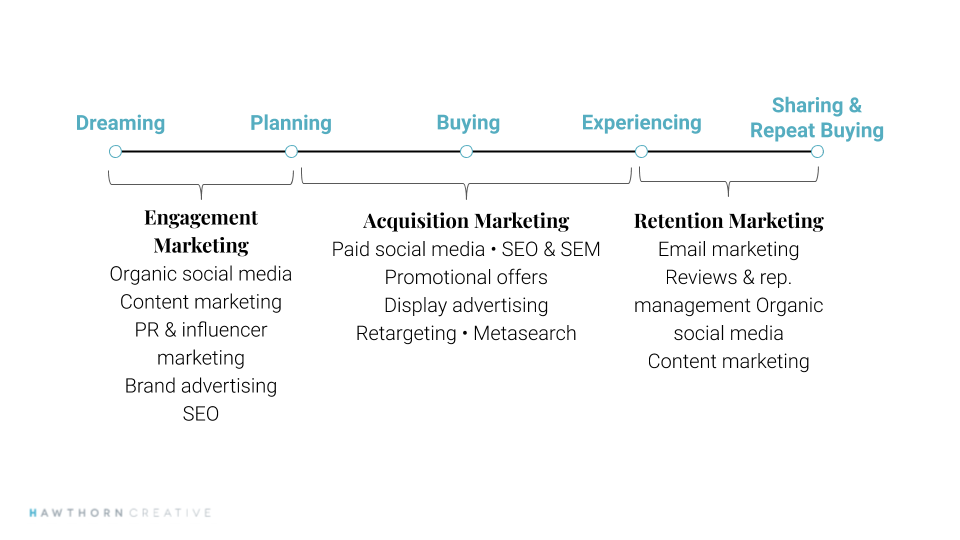What do Star Wars, Lord of the Rings, and The Odyssey all have in common with marketing? Both the characters in those stories, and our customers, follow a sprawling adventure or journey. Our brave fictional characters must follow the classic mythical, Hero’s Journey, and our daring customers must face the treacherous, Buyer’s Journey.
Unfortunately, I’m not here to talk about Star Wars – though, on almost all other occasions, I am your guy – so let’s dive into the Buyer’s Journey. Understanding the Buyer’s Journey is integral to crafting a complete marketing strategy. As our customers begin their journey, our marketing strategy needs to compliment every stage of their consideration to ensure there is a clear guided path to the decision we ultimately want them to take.
So, for us to best play the part of Gandalf or Obi-Wan Kenobi and guide our customers – our own heroes – on their journey to success, it is critical to understand exactly what lies ahead for them.
Need a Yoda To Guide Your Strategy? Request a Free Website Audit!
The Buyer’s Journey
These are the stages that every buyer goes through when making purchasing decisions:
Dreaming – Our buyer has been inspired or captivated and is now beginning to think about how a product or service (just like yours) would benefit their lives or solve a challenge they are facing.
Planning – Now that they are aware of their need, they have begun their research. They are considering their options and are gathering estimates, quotes, tours, or consultations.
Buying – They are ready to make their decision. They have compared all options and have found the best fit for their needs.
Experiencing – The purchase has been made, but the journey is far from over. Now it’s time for the product or service to fulfill the buyer’s need and the brand’s promise.
Sharing & Repeat Buying – If their experience was positive and what they hoped for, the buyer now has the opportunity to become a repeat customer, or better yet, a brand advocate, who will spread the word to their peers that they had an amazing experience with this product/service.
Okay, great, we have this down. Now we can start thinking about how our marketing strategy and our specific tactics fit into this journey. To make this easier, I’ve broken down all our marketing tactics into three segments. For your marketing strategy to be successful, you should make sure you hit each of these segments with equal efforts.

Engagement Marketing
These tactics are for the buyers who are just at the start of their journeys. Top of funnel, or early in the flywheel for all you Hubspotters out there. Covering the Dreaming and Planning stages in the journey, Engagement Marketing is all about spreading awareness and introducing your message to your audience for (likely) the first time. Messaging should focus on education rather than conversion. Let’s make sure our buyers really know what you do and why you do it, so they’ll more confidently move into the next stage of the Buyer’s Journey. KPIs should be centered around awareness, reach, eyeballs, and traffic.
Tactics Often Used in Engagement Marketing:
Organic Social Media
SEO
Influencer Marketing
Content Marketing
Acquisition Marketing
This is the consideration and decision-making step of the journey and often regarded as the most important time to really leverage your marketing tactics. You’ll see a lot of the same tactics used in this stage as in the prior, Engagement Marketing, but with firmer and more direct CTAs. Here, we are asking for the buyer’s business. Submit a form, schedule a tour or consultation, request a proposal. KPI’s are all about the conversions now and cost per conversion. Keep the former high and the latter low!
Tactics Often Used in Acquisition Marketing:
Paid Social Media Campaigns
Retargeting
SEM
SEO
Display Marketing
Retention Marketing
Hot Take Alert (Maybe?) – but this could actually be the most important segment of your marketing strategy. Who is the easiest person to sell to? How about someone who already bought from you and loves your product or service? Bingo. Retention is key to making the most of your existing client base and making sure they become an extension of your marketing strategy – think: brand enthusiasts and word of mouth. Done right, its networking done for you.
Tactics Often Used in Retention Marketing:
Email Marketing
Social Media (Paid & Organic)
Customer Reviews and Case Studies
Content Marketing
Some of you might not see a lot of repeat business. Like the nature of a wedding venue won’t see a lot of repeat customers, but retention is still EXTREMELY important. Instead of selling them again on your venue, you need to encourage them to share their great experience far and wide – it’s on you to make that as easy as possible. Social media is going to be critical for you in this sense – reviews, tagged locations, utilizing UGC (User Generated Content), etc.
So, there you have it. If you can understand your Buyer’s Journey, leverage that knowledge and join them from the start as their wise guide, you’ll have executed a marketing strategy that leads to a happy ending. The hero finds the service they went searching for, your guidance strategy led to a conversion, and your new client is a pleased one – so pleased, your story may even have a sequel. I know it’s not as cool or epic as destroying the Death Star or the One Ring, but what is?
Dan Seitz is the Director of Strategy at Hawthorn Creative and has helped execute marketing strategies for clients from all over the hospitality industry. He dreams of starting a blink-182 cover band called The Small Things.


